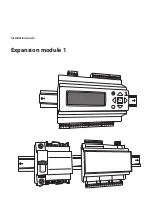
6
EXCLUSIVE
a
3.9
Elimination of air from the heating circuit
and from the boiler
(fig. 7)
During initial installation, or in the event of extraordinary
maintenance, you are advised to perform the following sequence
of operations:
1.
Open by two or three turns the automatic relief valve cap (
A
) and
leave
it open.
2. Open the system filling tap located under the appliance.
3. Switch on the electricity supply to the boiler, leaving the gas tap turned
off.
4. Activate a heat request via the room thermostat or the remote control
panel, so that the 3-way valve goes into heating mode.
5. Activate a request for DHW as follows: open a tap for 30 seconds so
that the three-way valve cycles from heating to DHW and vice versa for
about ten times (in this situation, the boiler will go into alarm due to lack
of gas, simply reset it whenever this is proposed).
6. Continue the sequence until no more air is coming from the air vent
valve.
7. Check the system pressure level is correct (
the ideal level is 1 bar
).
8. Turn off the system filling tap.
Turn on the gas tap and ignite the boiler
3.10
Draining the heating system
(fig. 16)
Before draining, switch off the electricity supply by turning off the main
switch of the system.
- Close the heating system’s flow and return valves.
- Connect a hose to the system drain valve (
C
).
- Manually loosen the system drain valve (
C
).
-
3.11
Emptying the domestic hot water system
If there is risk of frost, the domestic hot water system must be emptied in
the following way:
- turn off the main water inlet supply tap on the boiler
- turn on all the hot taps to drain.
3.12
Circulation pump settings
Modify only in specific circumstances
Circulator residual discharge head
The boiler is equipped with an already hydraulically and
electrically connected circulating pump, its useful available
performance is indicated in the graphs at page 43.
The circulator comes set from the factory with a 6 meter discharge
head curve. The boiler is equipped with an anti-seize system
which starts up an operation cycle every 24 hours in standby
mode
The “anti seize” function is active only if the boiler is electrically powered.
Operating the circulation pump without water is strictly forbidden.
If you need to use a different curve you can select the desired level on the
circulator. The main characteristics and the way to set up their desired
operation are listed. Below
3.12.1 Pump on board User interface
The user interface is made up of a button (
A
), a two-colored red / green
LED (
B
) and four yellow LEDs (
C
) arranged in a row.
The user interface allows the operating performance to be viewed (operating
status & alarm status) , it also allows the circulator operating modes to be
set.
The performance, indicated by the LEDs (
B
) and (
C
) is always visible during
normal operation of the circulator whereas settings can be carried out by
pressing the button (
A
).
3.12.2 Operating status indication
When the circulator is in operation the LED (
B
) is green. The four yellow
LEDs (
C
) indicate the electrical energy consumption (P1) as shown in the
following table.
LED status
CIRCULATOR status
Consumption in
% of MAX P1 (*)
Green LED on +
1 yellow LED on
Operating at minimum
0~25
Green LED on + 2
yellow LEDs on
Operating at
minimum-medium
25~50
Green LED on +
3 yellow LEDs on
Operating at medium-
maximum
50~75
Green LED on +
4 yellow LEDs on
Operating at maximum
100
(*) For the power (P1) absorbed by the circulator see the indications in the
“Technical Data” table.
3.12.3 Alarm status indication
If the circulator has detected one or more alarms the two-colour LED (
B
)
will be red. The four yellow LEDs (
C
) indicate the type of alarm as shown
in the following table.
LED status
ALARM
description
Status
CIRCULATOR
Possible
SOLUTION
Red LED on +
1 yellow LED
on (LED 5)
The drive shaft is
jammed
Start attempt
every 1.5
seconds
Wait or unjam
the drive shaft
Red LED on +
1 yellow LED
on (LED 4)
Low input
voltage
Warning only.
The circulator
continues to
operate
Check the
input voltage
Red LED on +
1 yellow LED
on (LED 3)
Electrical power
supply fault or
faulty circulator
The circulator is
stopped
Check the electrical
power supply or
replace the
circulator
If there are several alarms the circulator will display only the alarm with
the highest priority.
3.12.4 Display of active settings
With the circulator powered, press briefly on the button (
A
) to view the active
configuration of the circulator. The LEDs indicate the active settings.
In this phase no variations can be made to the circulator configuration.
Two seconds after the button (
A
) has been pressed the user interface
returns to the normal operating status display.
3.12.5 Key lock function
The purpose of the key lock function is to prevent accidental modifications
to the settings or the improper use of the circulator.
When the key lock function is activated, long-pressing the button (
A
) is
prevented. This prevents the user from entering the circulator’s operating
modes setting section.
Enabling/disabling the key lock function is achieved by pressing the button
(
A
) for more than 10 seconds. During this step all of the LEDs (
C
) will lash
for 1 second.
Содержание EXCLUSIVE 25C
Страница 43: ......







































